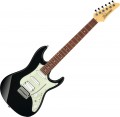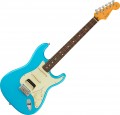Coil cutoff
The ability
to disable one of the coils in a humbucking pickup.
Pickups with this feature are, in fact, universal modules that can operate in both humbucking and single-coil modes. See "Pickup Diagram" for details on both. And the ability to switch between these modes allows the musician to change the colour of the sound without resorting to external gadgets or changing instruments. For example, for a dynamic composition with rich overdrive, it is more convenient to use a classic humbucker, and for a slow, lyrical melody, just move the switch and you can enjoy all the advantages of a single-coil.
Tone controls
The number of tone controls provided in the design of an electric guitar.
One tone control is responsible for the sound of the electric guitar as a whole; but if there are several such pens, they can have different formats of work. So, each knob can be responsible either for its own pickup, or for a separate frequency band. In the second case, a set of knobs plays the role of an equalizer that allows you to adjust the sound by changing the volume of low and high (sometimes even separately middle) frequencies.
Anyway, the presence of several tone controls expands the possibilities for changing the coloring of the sound by means of the guitar itself, without the use of additional equipment.
Pickguard
The presence of a protective lining (pickguard) on the body of the guitar.
Such an overlay is located on the upper deck, most often made of durable plastic and differs markedly in colour, due to which it is clearly visible. Its main purpose is to protect the soundboard surface from pick strikes (for example, when playing with dynamic fighting), which could damage the varnished wooden surface. The specific shape and size of the fingerboard may vary, but anyway, it covers at least the surface below the strings (when looking at the guitar in the working position), and sometimes under the strings and even above them.
Material
The material from which the body of an electric guitar is made. For models with cutouts (semi-acoustic, see "Type"), in this case, only the material of the back deck and sides can be taken into account, and data on the top deck is given separately (for more details, see "Deck Cover Material").
Now on the market there are cases of such trees:
red,
maple,
agatis,
ash,
alder.
It makes no sense to dwell on each of the materials found in modern electric guitars. Their variety is very large, however, unlike acoustic guitars, the body in this case does not play such a significant role in shaping the sound, and its material has a relatively small effect on the acoustic properties of the instrument (although the exact degree of such influence is a moot point). If you wish, you can find detailed data on a particular material in special sources, but in fact it makes sense to look primarily at the appearance of the instrument and its price category.
Body top
The material from which the soundboard cover is made is an additional overlay on the upper soundboard, which primarily plays a decorative role and gives the instrument a pleasant appearance. Do not confuse such a cover with a protective overlay (see above about it). And in semi-acoustic instruments with a hollow body (see "Type"), this paragraph may indicate the material of the upper soundboard, and a separate cover as such may be absent.
In general, the value of this parameter is similar to the material of the body (see above) — adjusted for the fact that the deck cover also directly determines the appearance of the electric guitar, and in semi-acoustic models it affects the sound more than the rest of the body. However, the main criterion for choosing this parameter may well be the aesthetic preferences of the musician.
Number of frets
The fret is the gap between the nut on the fretboard; each such interval is responsible for its own note (the interval between the frets is half a tone). Accordingly, the more frets, the more notes you can play on one string. However, keep in mind that the width of the gaps between the nut decreases as you get closer to the bridge, and if there are a lot of frets, playing at high frets can be difficult, requiring very high accuracy.
The most popular options today are
22 or
24 frets, they are found in most electric guitars of all types. In basses, there are also a smaller number (
20 frets and
21 frets), because. the distance between the nut on such instruments is greater, and the necks, respectively, with the same number of frets, are longer than those of guitars.
In general, paying attention to this parameter makes sense, first of all, for professional musicians, for whom a vast “space for manoeuvre” is fundamentally important.
A separate category is
fretless instruments, completely devoid of nut. Almost all of them relate to bass guitars; there are also electric guitars without frets, but very rarely. In such instruments, the role of the nut is played by the musician's finger, which presses the string to the fretboard. The technique of playing fretless guitars is noticeably mor
...e complicated: firstly, to extract clean notes, you need a very precise position of the finger; secondly, this design reduces the volume of the sound and the duration of the sustain, and special playing techniques may be required to obtain the sound of the desired volume (and heavier strings for basses). On the other hand, the lack of frets gives the professional musician a number of additional options. For example, on a fretless neck, you can make very smooth slides, without stepping between notes, and the instrument itself is not tied to a standard 12-step scale, which can be very useful in some areas of music (experimental, oriental, etc.). Also note that the fretless bass guitar, both in sound and playing technique, is very close to the classical double bass, which is especially appreciated by lovers of jazz and other similar styles.Nut width
The width of the fretboard of an electric guitar at the nut. Closer to the body, the neck may expand somewhat, but this is not necessary, and the expansion angle may be different. Therefore, the main size is considered to be the width in the region of the nut.
This parameter has two meanings. On the one hand, a wide neck is inconvenient for musicians with small hands and short fingers — it can be difficult to reach the far strings in such cases. On the other hand, a larger width means a greater distance between the individual strings, which reduces the likelihood of hitting an adjacent string when pressed incorrectly and can make playing easier (especially if the guitarist has large fat fingers). However, these moments are not absolute, and the convenience of playing is a very subjective matter, depending on many features of the musician and the technique he uses. Also, don't forget that necks can have different profiles (see above), and instruments with different neck profiles will feel differently in the hands even with the same width at the nut. Therefore, the most reliable method of selection is to try out the necks of different sizes and profiles “live”, decide on the best option and choose based on this.
The smallest neck width at the nut in modern electric guitars is about 39 mm. This size is found mainly in bass guitars (see “Type”), which have 4 strings and a neck that widens noticeably towards the body (due to which it can be made rather narr...ow from above, especially since when playing bass, notes are rarely clamped near the neck itself) . Electric guitars (including semi-acoustic) are somewhat wider — from 41 mm, an indicator of 43 – 48 mm is considered average, and in the largest instruments, the neck can be up to 55 mm wide (however, such dimensions are typical mainly for instruments with more than 6 strings) .
Fretboard radius
The radius of curvature of a fretboard mounted on the fretboard of an electric guitar.
The fingerboard is located directly under the strings, it is to it that the musician presses the strings when playing. If you look at the neck in cross section, its upper part with the overlay will have the shape of an arc; the radius of this arc is implied in this case. The smaller the radius, the more convex this arc will be, and vice versa, a large radius will correspond to an almost flat surface.
In general, it is believed that a smaller fingerboard radius is better for playing chords, and a more even, flat surface makes it easier to play technical passages with an abundance of special techniques such as bands. The average and, one might say, classic diameter value is 12", this is the most popular option among modern electric guitars. The smallest figure is just over 7", it is found in some guitars with Stratocaster bodies (both original Fender instruments and copies ). And the most flat pads have a diameter of 20" or more.
Note that there are often instruments with a variable fretboard radius — smaller at the headstock (where chords are played more often) and larger near the body (where solos are played by notes). In such cases, the radius at the nut is indicated.
Anchor
The type of truss provided in the design of the neck of an electric guitar.
The anchor has the form of an elastic metal rod installed along the neck and hidden inside. It reinforces the structure and prevents the neck from deforming from string tension. The truss rod can be made adjustable to suit the characteristics of the strings and compensate for the deformations that inevitably occur over time. The types of this detail can be as follows:
- Single. Anchor consisting of a single rod. The classic version used in most modern electric guitars, regardless of price category. Usually, the strength and rigidity of even a single rod is sufficient for normal applications and use.
- Double. Anchor, consisting, in accordance with the name, of two rods. It is distinguished by greater strength and reliability compared to a single one, in particular, it provides additional resistance to lateral deformations. On the other hand, the double construction is noticeably more expensive.

